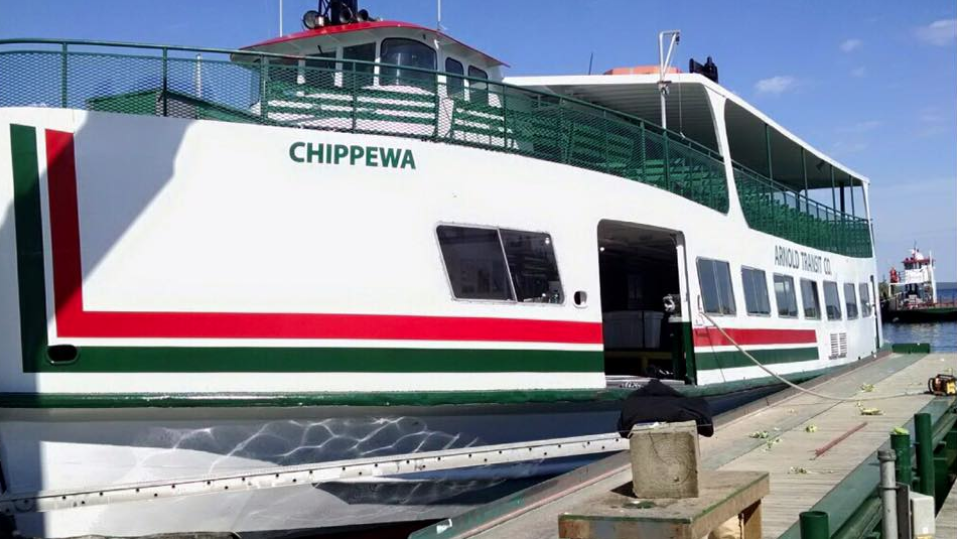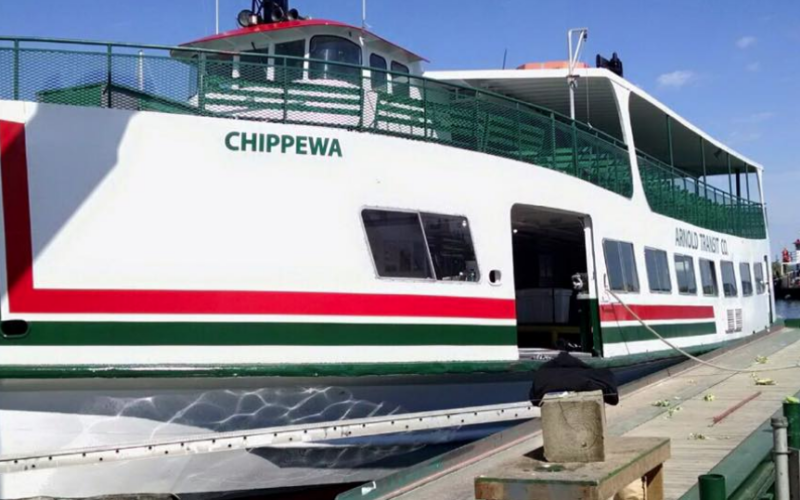(MACKINAW CITY, Mich.) — The Mackinac Island Ferry Co. is converting one of its passenger ferries from diesel to electric power, a transition made possible through a grant from the Michigan Department of Environment, Great Lakes and Energy.
The conversion is part of the company’s efforts to become more environmentally responsible and become Green Marine certified. The certification means a marine company is exceeding regulatory standards and taking tangible action to preserve the environment.
“More and more ferry operators are seeking Green Marine environmental certification as a scalable, easy-to-communicate, tangible way to benchmark, improve and showcase their sustainability commitment,” said David Bolduc, Green Marine president. “We’re happy to welcome Mackinac Island Ferry Co. among this growing membership as the first Michigan ferry operator to join our program.”

The $3.06 million in funding from the state of Michigan will help the ferry company replace two 1988 diesel engines on the ferry Chippewa with electric propulsion motors. Work was scheduled to begin immediately on the project after an announcement earlier this year. That project includes redesigning and modernizing various parts of the ship over the next two to three years.
Chippewa is a pilot project for the electrification of 28 Mackinac Island ferries. The conversion will reduce greenhouse gas emissions by 14,152 metric tons of carbon dioxide equivalents and 887 metric tons of nitrogen oxides over the boat’s lifetime.
The grant covers half the cost of the project, which will include installing 1.5 megawatts in shore power infrastructure at the Mackinaw City ferry dock. Electric power upgrades are also planned for the ports of St. Ignace and Mackinac Island.
The ferries are the primary means of transportation to Mackinac Island, serving about 500 year-round islanders and 750,000 visitors a year, with a summer peak of more than 16,500 a day. During peak months, ferries make up to 125 round trips a day.
The Mackinac Island Ferry Co. is the first ferry operator in Michigan to join Green Marine. Jerry Fetty, CEO of the ferry company, sees the move as another milestone in the company’s effort to provide a sustainable experience while preserving the natural beauty along lakes and islands across Michigan shores. The company runs ferries to Mackinac Island from both Mackinaw City and St. Ignace.
Green Marine is a voluntary environmental certification program for the North American maritime industry. Green Marine was created 15 years ago as a binational program aimed at the Great Lakes and St. Lawrence region. It grew to all of North America in 2010 and has had a sister program in Europe since 2020.
The organization guides the maritime industry toward environmental excellence by encouraging enterprises to adopt concrete measurable actions that go beyond regulatory obligations. The program deals specifically with issues related to maritime transportation, such as the quality of air, water and soil, as well as community relations. The inclusive, transparent initiative brings together shipowners, ports, terminals, shipyards and the Seaway corporations based in Canada and the United States.
Other Green Marine participants in Michigan include the Port of Monroe, a deep-draft commercial harbor and Michigan’s only port on Lake Erie; and Grand River Navigation in Traverse City, a leading provider of bulk freight services on the Great Lakes.
The Mackinac Island Ferry Co. uses alternative energy sources like a full Tesla supercharging station at the Mackinaw City dock and has three EV charging stations at its St. Ignace. It also has multiple electric vehicles in use on the dock. In addition, the company is reducing wastewater levels through the creative recycling of used boat oil and vegetable from Mackinac Island restaurants for heating purposes
Other tangible practices across the industry include equipping all company ships with recycling bins and giving staff proper training on established user procedures and waste management hierarchy (reduce, reuse, recycle, recovery, disposal).
Other examples include:
• Encouraging the use of reusable, biodegradable and/or recyclable supplies.
• Implementing a replacement program for LED or other energy-efficiency light upgrades.
• Following voluntary slow speed measures in specific zones, as identified by port or governmental authority.
• Using climatology and weather forecasting to take advantage of tidal currents and avoid storms, and planning voyages to reduce running hours and idling time.
Green Marine requires continual improvement from its participants in order to achieve the mission of advancing environmental excellence within the maritime industry. To obtain their certification, Green Marine participants must demonstrate continual and measurable improvement, year after year, and respect all elements of the certification process, i.e., the annual self-evaluation, external verification and publication of results.
– Mackinac Island Ferry Co.

